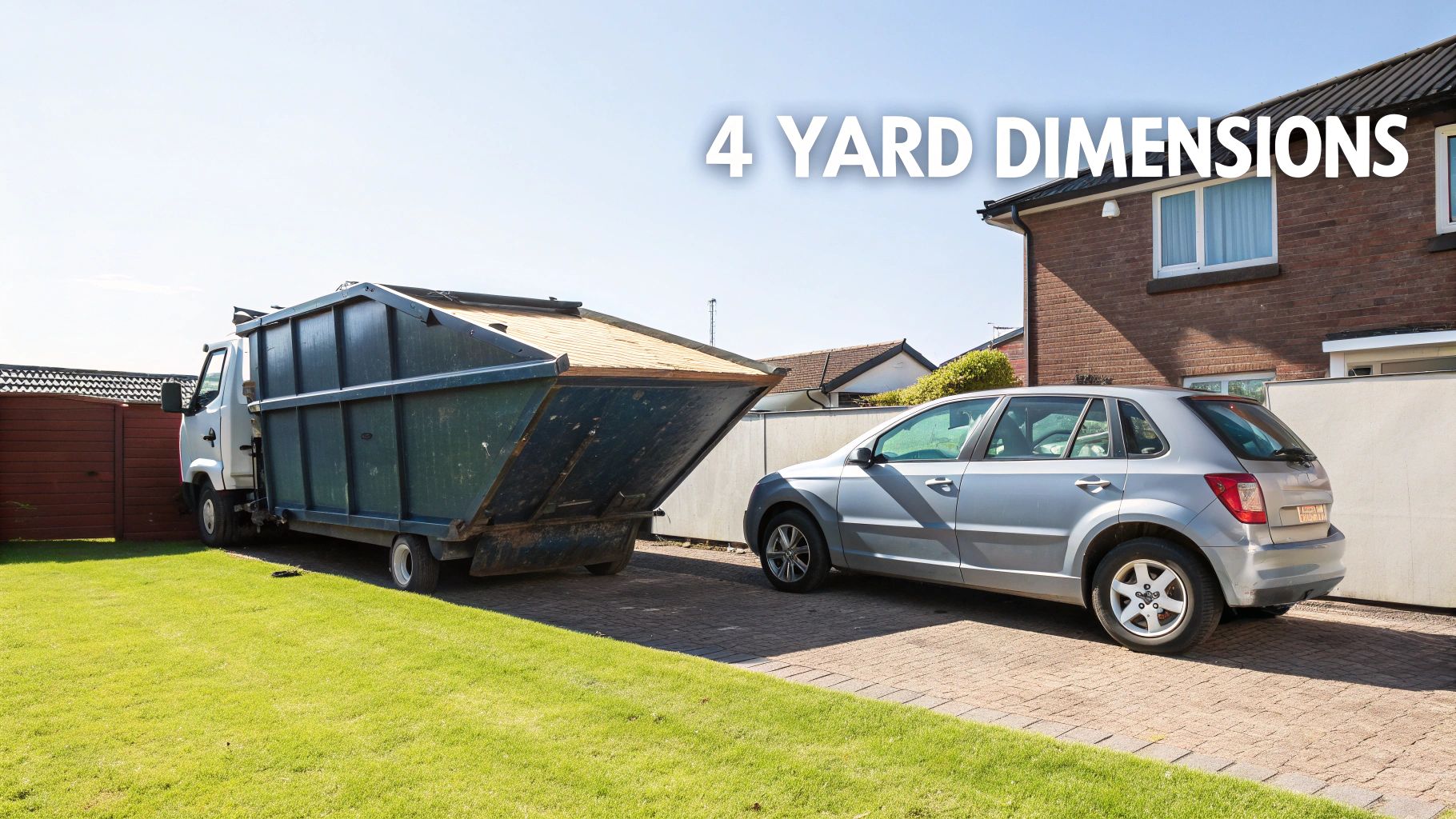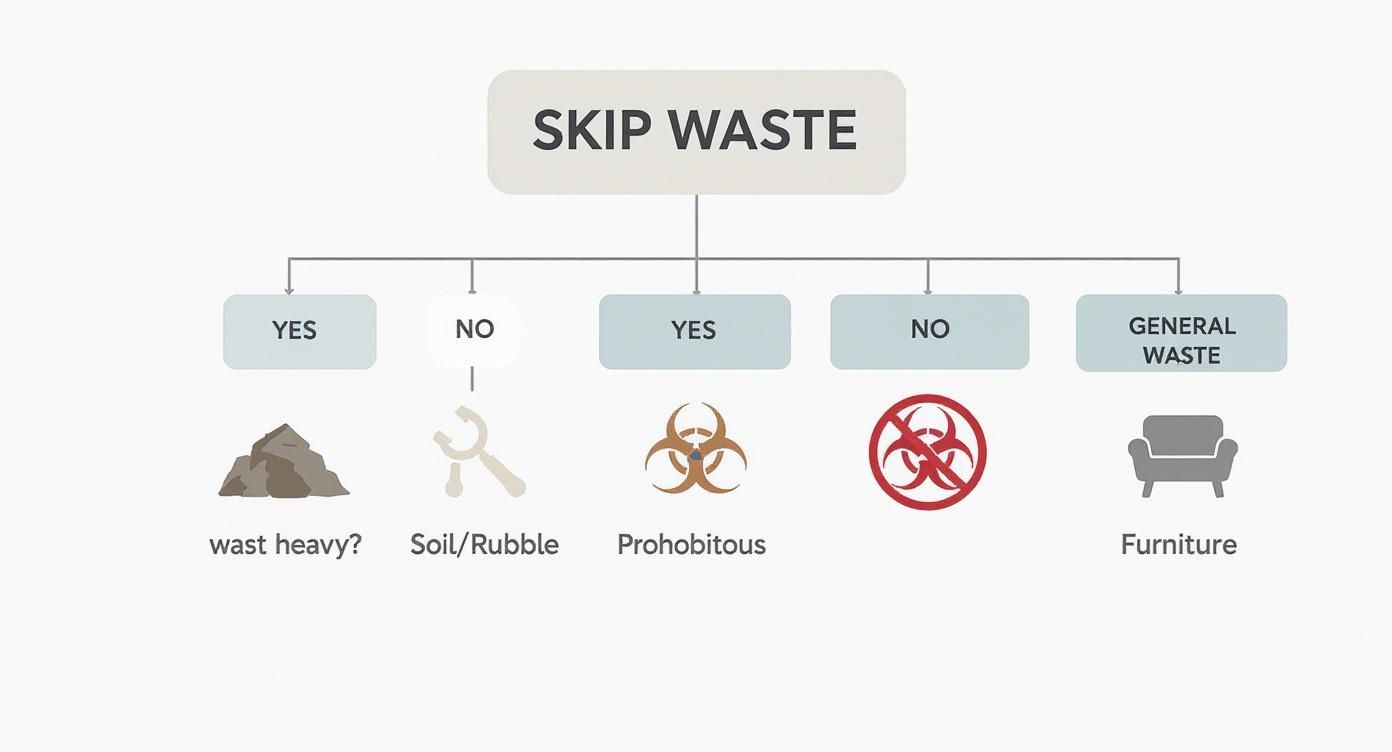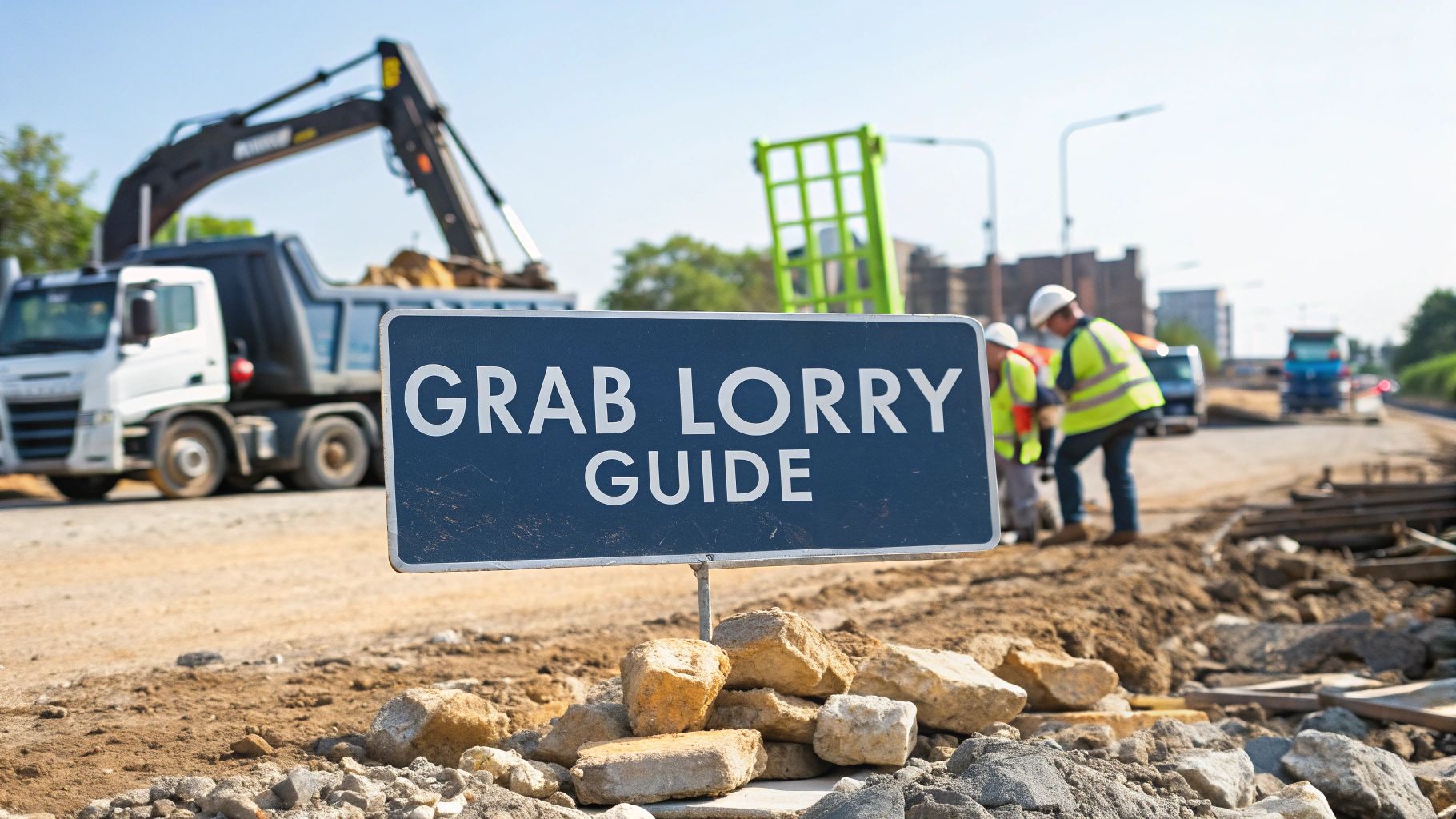size of 4 yard skip: What You Need to Know
size of 4 yard skip: What You Need to Know
Often called a 'midi' skip, the 4 yarder is one of the most versatile and popular sizes out there. It hits that sweet spot for small to medium-sized projects, being compact enough for most driveways while still offering a decent amount of space for your waste.
The typical dimensions are roughly 1.83 metres long, 1.29 metres wide, and 0.97 metres high. It’s a tidy little package that packs a surprising punch.

What Do the 4 Yard Skip Dimensions Actually Mean?
Getting your head around the numbers is the first step to hiring with confidence. While the exact measurements might vary a tiny bit from one supplier to the next, the volume is what really counts. A 4 yard skip holds exactly what its name suggests: four cubic yards of waste.
But what does that look like in real terms? Think of it as holding around 30 to 40 standard black bin bags. This makes it the go-to choice for those household jobs where a tiny 'mini' skip just won't cut it, but a full-size builder's skip would be overkill.
To help you visualise it, its footprint on the ground is about the same as a small family car like a Ford Fiesta. This is great news for anyone with limited space. If you're still weighing up your options, our guide on what size skip you might need can help you make the final call.
4 Yard 'Midi' Skip Specifications at a Glance
To make things simple, here’s a quick rundown of the key details for a standard 4 yard skip. These figures are a great reference point when you're planning your project.
| Specification | Approximate Measurement |
|---|---|
| Length | 1.83 m (6 ft) |
| Width | 1.29 m (4 ft 3 in) |
| Height | 0.97 m (3 ft 2 in) |
| Capacity (Bin Bags) | 30-40 bin bags |
These compact yet practical measurements are exactly why the 4 yarder is such a firm favourite across the UK, perfect for everything from garden clear-outs to small-scale trade jobs.
Visualizing What Fits Inside a 4 Yard Skip
Knowing the dimensions is one thing, but the real question on everyone's mind is: what can you actually get inside a 4-yard skip? This is where its size really shines, making it a perfect fit for a whole host of common household and garden jobs.

To get a good mental picture, think of its capacity as roughly the same as a small builder's van. Or, if you prefer, imagine eight to ten standard washing machine drums filled with rubbish. That's a decent amount of space, making it an ideal partner for projects that create a fair bit of waste but don't need a giant industrial container.
Common Projects for a 4 Yard Skip
This skip is the go-to solution for those in-between jobs – the ones that are far too big for your wheelie bin but don't quite justify a massive builder's skip. It's brilliant for getting rid of a mix of bulky items and general rubbish all in one go.
For instance, if you're renovating a small space kitchen, a 4-yarder can easily handle all the debris without taking up your entire drive. It's a top choice for lots of other domestic clear-outs, too.
Here are a few classic examples:
- Small Kitchen or Bathroom Rip-Outs: Got old cabinets, countertops, tiles, and maybe an old sink or toilet? They'll all fit.
- Major Garden Clearances: Perfect for shifting soil, turf, that old shed you've finally dismantled, broken fence panels, and a large amount of green waste.
- Full Garage or Loft Declutters: It has plenty of room for old furniture, broken appliances, countless boxes of junk, and all that other clutter you've been meaning to sort.
One of the biggest advantages of the 4-yard skip is its ability to handle both bulky items and heavy waste like soil or rubble. This is something smaller skips often struggle with, making the 4-yarder a seriously versatile choice for mixed-waste projects.
What Exactly Can You Fit Inside?
Let's get more specific. Imagine you're loading one up. You could comfortably fit something like a dismantled small wooden shed, a few old kitchen units, and even an old three-piece suite (if you break it down first).
On the other hand, if you're dealing with heavy stuff, it can handle about four tonnes of materials like soil, concrete, or bricks. This makes it a popular choice for groundwork or small landscaping jobs where you need to get rid of dense, heavy debris safely and without any fuss.
Weight Limits and What Can Go Inside
It's not just about the physical size. When you hire a 4 yard skip, you also need to get to grips with weight limits and what you can and can't throw in. Getting this right is key to a smooth, hassle-free hire and staying on the right side of the law.
A 4 yard skip can comfortably hold up to four tonnes of waste. This generous limit makes it a brilliant choice for those heavy, dense materials that would overwhelm a smaller skip. Think soil, bricks, rubble, and broken concrete from a garden project or a small knock-through job.
But there's a golden rule: you must stick to a 'level load'. This just means keeping all your waste inside the skip's walls, not piling it up high. Overfilling isn't just a bit cheeky—it's dangerous and illegal. The driver simply won't be able to collect an overloaded skip, and you don't want that headache.
What Can You Put in a 4 Yard Skip?
Knowing what’s allowed and what's a definite no-no will save you a world of trouble. While most household or garden clear-outs will fall under 'mixed waste', it's worth checking the specifics. For a deeper look into the nitty-gritty of skip capacities, our guide on if skips have a weight limit has all the details.
To make things simple, here's a quick rundown of what we accept versus what needs to be kept out.
What Can and Cannot Go in Your 4 Yard Skip
| Permitted Waste | Prohibited Waste |
|---|---|
| General household waste (e.g., old toys, clutter) | Asbestos (requires specialist disposal) |
| Wood, metal, and plastics | Plasterboard (must be disposed of separately) |
| Soil, bricks, rubble, and concrete | Hazardous materials (e.g., paint, solvents, oils) |
| Furniture and non-electrical fittings | Electrical items (WEEE), including fridges and TVs |
| Garden waste (e.g., branches, turf, leaves) | Tyres, gas cylinders, and batteries |
It’s crucial to keep prohibited items separate. Trying to sneak things like plasterboard or old paint tins into the bottom of the skip might seem tempting, but it can lead to the whole load being rejected or you being hit with extra charges for proper disposal. If you’re ever in doubt, just ask. It’s always better to be safe than sorry.
How the 4 Yard Skip Compares to Other Sizes

Choosing the right skip size is always a bit of a balancing act. You're weighing up capacity, cost, and the sheer convenience of getting it on your property. To really get a feel for where the 4 yard skip fits in, it helps to put it side-by-side with its closest neighbours: the smaller 2 yard 'mini' skip and the larger 6 yard 'small builder's' skip.
First up, the 2 yard skip. This is the smallest option you'll find, and it's perfect for those minor clear-outs. Think of a weekend spent doing some light gardening or finally decluttering that one small room. It’s compact and cheap, but you'll quickly find its limits—it really can't handle bulky items or heavy waste like soil and rubble.
At the other end of the spectrum is the popular 6 yard skip. This is the go-to size for general building work and bigger domestic projects across the UK. It offers a significant amount more space, making it the right choice for things like kitchen renovations, getting rid of multiple pieces of bulky furniture, or more serious construction jobs. For a full breakdown, check out our guide on how big a 6 yard skip really is.
Making the Right Choice
This is where the 4 yard skip shines. It’s the perfect middle ground. You get double the space of a 2 yarder, which means it can comfortably handle the waste from a small bathroom renovation or a major garden clearance, all without the higher cost and larger footprint of a 6 yard skip.
The real key is matching the skip to the job you're doing. If you overestimate, you're just paying for empty space. But if you underestimate, you're stuck with the cost and hassle of ordering a second skip. For many common household projects, the 4 yard midi often hits that sweet spot and proves to be the most cost-effective solution.
If you're unsure what can actually go in a skip, this simple decision tree can help you quickly figure it out.

As you can see, heavy waste like rubble is absolutely fine, but hazardous materials are always a no-go. The data doesn't lie: domestic skip hire in the UK is dominated by smaller sizes like the 4 and 6 yard skips, which give you around 3.65 to 4.6 cubic metres of capacity. Thanks to its manageable dimensions, the 4 yard midi is often the favourite for garden waste and those smaller-scale jobs.
Sorting Your Skip Placement and Council Permits
Figuring out the right size skip is one thing, but knowing where you're legally allowed to put it is a whole different ball game. Where you decide to place the skip will determine whether you need to get the local council involved, which can impact both your schedule and your budget.

By far the easiest option is to have the skip placed on your own private land. Think your driveway, garden, or yard. As long as the skip is completely within the boundary of your property, no permit is needed. Simple. This is always the quickest and cheapest way to go.
But what if you don't have a suitable private spot? In that case, the skip will have to go on a public road or pavement. If this is your only option, then a council-issued skip permit becomes a legal must-have. Don't be tempted to skip this step, as you could face some pretty hefty fines.
Getting a Council Skip Permit Sorted
Now, arranging a permit might sound like a hassle, but this is where a good skip hire company earns its stripes. When you book with a reputable firm like The Waste Group, we handle the entire application process for you. It's all part of the service and makes sure everything is done by the book.
It’s important to know that getting a permit isn't an overnight job. Councils usually need a few days to process the application, so you absolutely have to factor this into your project timeline. Last-minute bookings for on-road skips are rarely ever possible for this reason.
Permit costs change depending on your local council, but you can typically expect to pay anywhere from £30 to over £100.
When a skip is on public land, it also needs to be fitted with safety lights and traffic cones so it's clearly visible, especially at night. This is a non-negotiable safety measure that your skip provider will sort out for you.
To make sure everything goes off without a hitch, it's a good idea to clear the delivery area and check for any low-hanging cables before the lorry arrives. A little bit of prep goes a long way towards a smooth, trouble-free hire.
Common Questions About 4 Yard Skips
Even with all the key details laid out, you probably still have a few practical questions buzzing around. Let's run through some of the most common queries we get about hiring a 4 yard skip, so you can finalise your plans with complete confidence.
How Much Does Hiring a 4 Yard Skip Cost?
The price for hiring a 4 yard skip isn't set in stone across the UK; it often depends on your specific postcode and the type of waste you're getting rid of. As a general guide, you can expect the cost to land somewhere between £150 and £220.
This price nearly always covers everything you need: the skip delivery, collection once you're done, and all the costs of processing the waste responsibly. It's worth remembering that prices in London and the South East tend to be at the higher end of that scale.
Do I Need a Permit on My Driveway?
Good news on this one. If the skip is placed entirely on your private property – like your driveway or in your garden – you do not need a council permit.
You only have to worry about a permit if any part of the skip needs to sit on public land. This means the road, pavement, or even the grass verge outside your house. Always be certain your chosen spot is 100% private land to avoid any unexpected fines.
The standard hire period for a skip is usually one to two weeks (7-14 days). Most companies, including us, are pretty flexible. If you finish your project early, you can just arrange for a quicker collection. Need it for a bit longer? That can usually be sorted out when you make the booking.
Can a 4 Yard Skip Take Soil and Rubble?
Absolutely. The 4 yard midi skip is a brilliant choice for heavy, dense waste like soil, bricks, concrete, and broken-up rubble. Its strong build is perfectly suited to handle that significant weight without giving the collection lorry any trouble with legal lifting limits.
One quick tip: it's best not to mix huge amounts of heavy waste with light general rubbish. And when you're planning any project, it's always a good idea to have a list of questions to ask contractors about how they plan to manage their waste. If you know you'll have a lot of soil, give your skip hire company a heads-up – they might even offer a better rate for a load that is purely inert waste.
Ready to book your 4 yard skip or just need a bit more advice? At The Waste Group, our friendly team is here to help. Order online today for a hassle-free experience.


